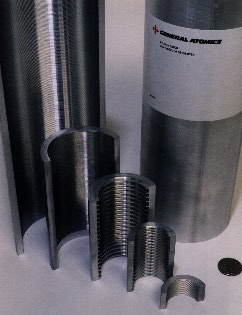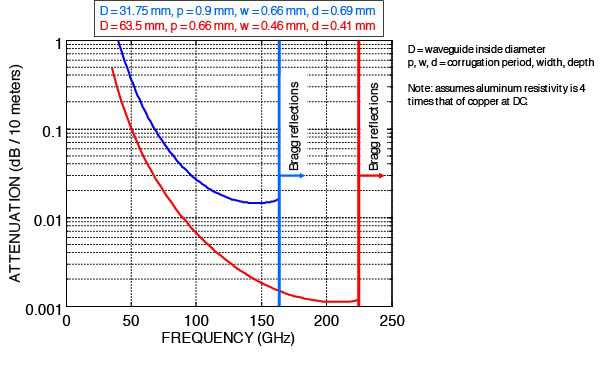Straight Corrugated Waveguides

General Atomics supplies circular corrugated waveguides with inside diameters from 31.75 mm (1.25") to 88.9 mm (3.5") in lengths up to 2.13 meters (7 feet). Popular diameters are 31.75, 45, 60.3, and 63.5 mm.
Depending on the size and corrugation geometry, these waveguides propagate the low-loss HE11 mode from 28 GHz to over 300 GHz. They can also be used to transmit the circular TE01 mode in bends with low loss at frequencies as low as 10 GHz.
In addition to 6061-T6 aluminum, waveguides are available in CuCrZr and 316L stainless steel.
APPLICATIONS
- Industrial processing systems using millimeter waves
- Electron cyclotron heating of fusion plasmas
- Plasma diagnostics
- Submillimeter laser cavities
- Antenna feeds
FEATURES
- Extremely low loss (as low as 1% per 100 meters)
- Extremely large bandwidths in the HE11 mode (up to 8:1 or more)
- Excellent radiation patterns
- High-power transmission (up to 1 MW in air; higher in vacuum)
- Thick wall tubing allows for stable alignment
- Helicoflex® vacuum seals can be located between waveguides
- Waveguides are relatively lightweight even in the largest size
- Can be used with quasi-optical equipment such as miter bends
COMPARISON OF HE11 WITH TE01 TRANSMISSION
- Ohmic (wall) loss for HE11 is comparable to that for TE01
- Mode conversion loss at miter bends for HE11 is only about 35% that for TE01
- HE11 continuous curvature bends can be about half as long as for TE01
- HE11 is better separated from competing modes, so propagation is less sensitive to wall distortions
- HE11 mode at open-ended corrugated waveguide couples directly to the fundamental free space Gaussian mode with less than 2% loss over wide bandwidths
- The far field radiation pattern from open-ended HE11 waveguide is centrally peaked with low sidelobes. The TE01 pattern is doughnut shaped.
- HE11 can propagate in any polarization, from linear to circular. HE11 linear propagation is nearly ideal, with negligible cross polarization.
- Quasi-optical polarizers and transmission filters can be made with gratings on miter bend mirrors in HE11 transmission lines.
LARGE BANDWIDTH PROPERTIES OF THE HE11 MODE
- The maximum low-loss frequency is related to the corrugation width and period.
- The minimum low loss frequency is related to the corrugation depth.
- The upper frequency for guaranteed low loss is determined by the period p of the corrugations. If the wavelength is less than twice the period of the corrugations, Bragg reflections can occur due to the periodicity of the structure.
- In waveguides with larger diameter, Ez and Hz are smaller. Hence low loss can be achieved with a smaller reactance, Xz, from the corrugations. This reactance depends on the ratio of corrugation depth to the wavelength. Hence low loss can be achieved at lower frequency.
- In normal situations, the practical corrugation depth, d, is limited to about the corrugation width, w. For convenience in machining, w/p is typically about 0.7.
- The maximum wavelength is equal to the square root of the quantity, (0.5 times the diameter times the minimum wavelength).


